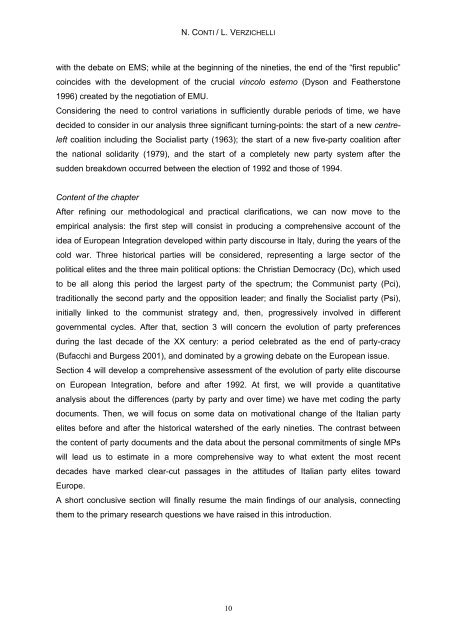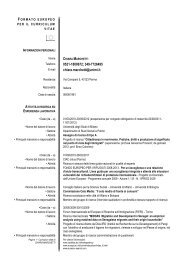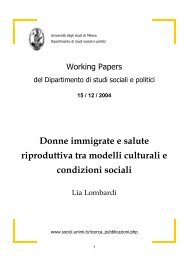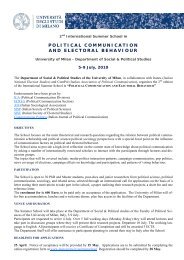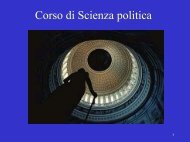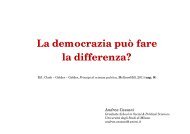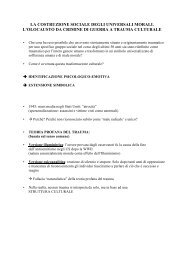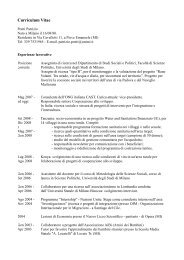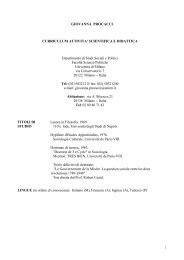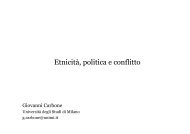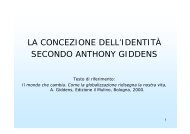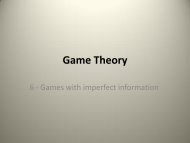The european dimension of political discourse in Italy. A ... - CIRCaP
The european dimension of political discourse in Italy. A ... - CIRCaP
The european dimension of political discourse in Italy. A ... - CIRCaP
Create successful ePaper yourself
Turn your PDF publications into a flip-book with our unique Google optimized e-Paper software.
N. CONTI / L. VERZICHELLI<br />
with the debate on EMS; while at the beg<strong>in</strong>n<strong>in</strong>g <strong>of</strong> the n<strong>in</strong>eties, the end <strong>of</strong> the “first republic”<br />
co<strong>in</strong>cides with the development <strong>of</strong> the crucial v<strong>in</strong>colo esterno (Dyson and Featherstone<br />
1996) created by the negotiation <strong>of</strong> EMU.<br />
Consider<strong>in</strong>g the need to control variations <strong>in</strong> sufficiently durable periods <strong>of</strong> time, we have<br />
decided to consider <strong>in</strong> our analysis three significant turn<strong>in</strong>g-po<strong>in</strong>ts: the start <strong>of</strong> a new centreleft<br />
coalition <strong>in</strong>clud<strong>in</strong>g the Socialist party (1963); the start <strong>of</strong> a new five-party coalition after<br />
the national solidarity (1979), and the start <strong>of</strong> a completely new party system after the<br />
sudden breakdown occurred between the election <strong>of</strong> 1992 and those <strong>of</strong> 1994.<br />
Content <strong>of</strong> the chapter<br />
After ref<strong>in</strong><strong>in</strong>g our methodological and practical clarifications, we can now move to the<br />
empirical analysis: the first step will consist <strong>in</strong> produc<strong>in</strong>g a comprehensive account <strong>of</strong> the<br />
idea <strong>of</strong> European Integration developed with<strong>in</strong> party <strong>discourse</strong> <strong>in</strong> <strong>Italy</strong>, dur<strong>in</strong>g the years <strong>of</strong> the<br />
cold war. Three historical parties will be considered, represent<strong>in</strong>g a large sector <strong>of</strong> the<br />
<strong>political</strong> elites and the three ma<strong>in</strong> <strong>political</strong> options: the Christian Democracy (Dc), which used<br />
to be all along this period the largest party <strong>of</strong> the spectrum; the Communist party (Pci),<br />
traditionally the second party and the opposition leader; and f<strong>in</strong>ally the Socialist party (Psi),<br />
<strong>in</strong>itially l<strong>in</strong>ked to the communist strategy and, then, progressively <strong>in</strong>volved <strong>in</strong> different<br />
governmental cycles. After that, section 3 will concern the evolution <strong>of</strong> party preferences<br />
dur<strong>in</strong>g the last decade <strong>of</strong> the XX century: a period celebrated as the end <strong>of</strong> party-cracy<br />
(Bufacchi and Burgess 2001), and dom<strong>in</strong>ated by a grow<strong>in</strong>g debate on the European issue.<br />
Section 4 will develop a comprehensive assessment <strong>of</strong> the evolution <strong>of</strong> party elite <strong>discourse</strong><br />
on European Integration, before and after 1992. At first, we will provide a quantitative<br />
analysis about the differences (party by party and over time) we have met cod<strong>in</strong>g the party<br />
documents. <strong>The</strong>n, we will focus on some data on motivational change <strong>of</strong> the Italian party<br />
elites before and after the historical watershed <strong>of</strong> the early n<strong>in</strong>eties. <strong>The</strong> contrast between<br />
the content <strong>of</strong> party documents and the data about the personal commitments <strong>of</strong> s<strong>in</strong>gle MPs<br />
will lead us to estimate <strong>in</strong> a more comprehensive way to what extent the most recent<br />
decades have marked clear-cut passages <strong>in</strong> the attitudes <strong>of</strong> Italian party elites toward<br />
Europe.<br />
A short conclusive section will f<strong>in</strong>ally resume the ma<strong>in</strong> f<strong>in</strong>d<strong>in</strong>gs <strong>of</strong> our analysis, connect<strong>in</strong>g<br />
them to the primary research questions we have raised <strong>in</strong> this <strong>in</strong>troduction.<br />
10


